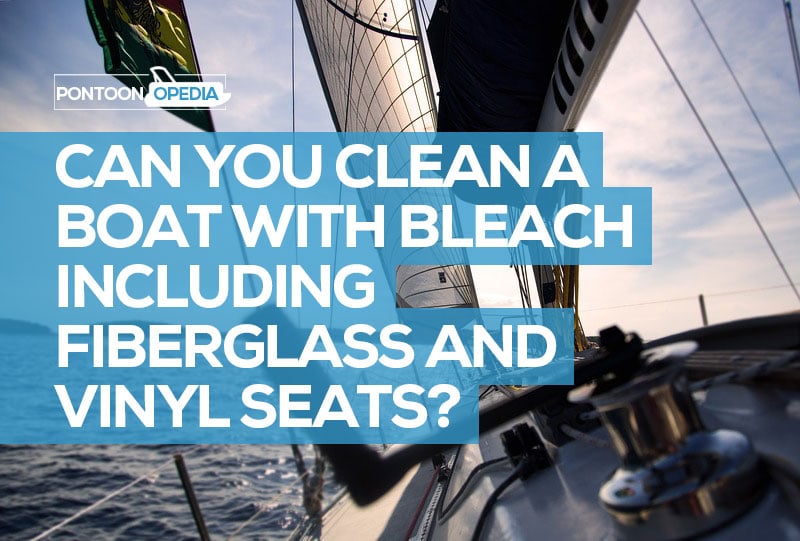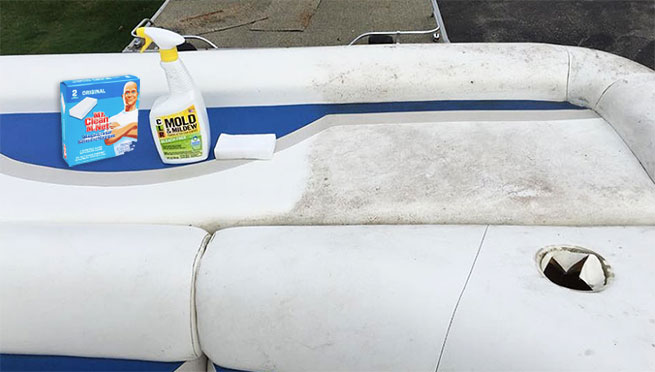If you want to get your boat clean and want a cheap shortcut, then bleach could be something that you are considering using. It’s tempting to use it, as it could give you great results on a fiberglass boat, vinyl seats, and panels. But does it work and is it safe?
You can clean a boat with bleach, but it does contain very harsh chemicals and over time can damage gel coats on fiberglass boats, degrade vinyl seating threads, vinyl boat wraps, discolor and fade paint, and lead to corrosion in boat fittings and fixtures.
That’s my quick disclaimer and answer done with, but let’s get into a little bit more detail on cleaning fiberglass boats, seats, and boat panels with a bleach-based cleaner.
Cleaning boat seats with bleach
Vinyl boat seats are notoriously hard to clean if they have been neglected for a while. They aren’t many boat owners out there who haven’t experienced mold and mildew on their white vinyl.
But can you clean boat seats with bleach and is it safe?
I don’t recommend it all.
Whilst you might get good results, even if you diluted it with water, for me it’s too much of a risk. Over time, and if you continue to repeat the cleaning process using a bleach-based product you could find that the seams in your seats start to degrade. I’ve had this on my captain’s chair, and ended up having to replace it (see what I bought here).
Bleach and strong chemicals can shift really stubborn stains in boat seats, but they will also start to attack the thread that keeps your seats held together.
Instead I recommend using products like Magic Eraser. You can see some before and after photos of boat seats cleaned with this and other products instead of bleach. The results are very impressive, and a lot safer – and way better than bleach (or vinegar).
For a step by step process on how to safely clean vinyl boat seats, read this guide.
Whether bleach is good for cleaning boat seats though is open to debate, and I leave you with some comments I found on boating forum from a user who did use bleach on his vinyl seats. And he got good results as you can read below.
“After trying virtually everything to remove the black mildew spots on the top areas of my seats and especially the top of the stern area, I finally tried some bleach with diluted water, and it worked very well and didn’t stain a thing. I was extremely reluctant to try it as some people claimed it would not only stain the vinyl seating, it would also weaken the threads. I went for it though and used bleach mixed 1 cup in a gallon of water. I did about 7 different applications of this solution, rubbing it in with an old hand towel. After 5 minutes of soaking in and baking in the sun I used a different towel and soaked it in clean water and then went over the same areas. I wish I would have taken before and after photos because it really was quite remarkable.”
For full disclosure, other people on the boating forum I found this on did reply to say that their experiences of using bleach on vinyl seating was negative. Here was a typical response the original poster received back:
“I talk from personal experience as having made this mistake. Using bleach on my seats weakened the threads in my upholstery. Yes, it got rid of the mildew really well and I didn’t get any stains as I wiped off immediately after application and gave it a thorough rinse. But after two years the threads in my seats had started to degrade and fray, and I can only assume it was due to my frequent bleach cleaning.”
Can you clean a fiberglass boat with bleach?
I own a pontoon boat myself but do have friends who own fiberglass boats and have used bleach for years.
One of my boating buddies dilutes half a cup of dish washing liquid with a cup of bleach which is then mixed into a bucket of water.
I wouldn’t do this, because dish washing liquid can strip wax and protective coatings off, but he swears at the results he gets.
This is what he said to me about how bleach works as a cleaner on his fiberglass boat:
“Around 10 years back I started to add bleach into soap on my fiberglass and have had amazing results ever since. I know you should not mix detergent and bleach together, but it works so well, I’ve never done anything else. I use Dawn soap and bleach but did notice that the wax started to come off. But it does give me a really shiny and great looking gelcoat. This method is not great for metals though, and I have seen little films of rust in the crevices which I believe is down to the bleach.”
I didn’t just want to take his word for it though and wanted to find some more authoritative and trusted information on the subject matter. I found this paragraph on the Boat US website:
Cleaning fiberglass boats with bleach
“The first step in restoring the gloss to dull gelcoat is always a thorough cleaning. Add a cup of detergent to a gallon of water — warm water is better — and use a sponge to wash the surface with this solution. Be sure to protect your hands with rubber gloves. If mildew is present, add a cup of household bleach to your cleaning solution. Difficult stains like fish blood and waterline scum may require the direct application of a concentrated cleaner formulated for fiberglass. Rinse the clean surface thoroughly and let it dry.”
I am still not 100% convinced though, as also spoke to a marine cleaning company who clean boats for a living. I appreciate that they might have a vested interest in the matter as would rather you pay them, but for me, they are the boat cleaning experts. This is what they told me last week:
“Bleach and fiberglass boats do not mix, and if you aren’t sure, go test it yourself and see what results you get! In fact, The Australian agency, CSIRO who do scientific tests took two jars, with fiberglass in boat. One jar had bleach and water in it, one had just water and a marine cleaning product. After 2 weeks, the fiberglass that had been soaking in just bleach and water came out really floppy and damaged.”
For me, that’s the test that actually does go to prove that yes, you can clean a fiberglass boat with bleach, but it’s going to damage it in the long run.
Cleaning a boat with bleach using alternative green solutions
Another consideration is the environment. Do you really want bleach running into your local waters when cleaning your boat? I know I wouldn’t.
There are greener products on the market which will do a good job, without the nasty environmental side effects.
Here’s what a spokesperson for Boat US said:
“If you’re cleaning your boat with lots of soap and not diluting it like you’re supposed to and then rinsing it all off into the water, it doesn’t matter if you’re using the greenest boat soap out there because you’ll have more of an impact than the person who’s working with a really toxic product but wiping it off with a rag.”
So, whilst there are non-toxic cleaners, you still need to be very mindful on how you use them.
I found a non-toxic boat cleaner that can be used as an alternative to bleach on Amazon. It’s by Star Brite – you can view prices and reviews here. It’s safe to use on fiberglass, glass, vinyl, plastic, metal, rubber and painted surfaces and is said to not remove any wax or boat polish.
Tips on boat cleaning without bleach
The American Sailing Association published some tips on their website on how to clean your boat whilst still doing your bit for the environment. I’ve copied those below:
- Keeping your boat rinsed regularly will prevent the need to use boat soap, saving the environment and saving you time and money.
- Using a protective boat wax will decrease the chances of dirt and grease becoming stuck to your boat. Less harsh ingredients (such as baking soda and vinegar) will prolong the life of your boat wax.
- More toxic cleaning sprays are better for the environment if you perform spot checks with them and minimize runoff by using a towel or rag.
- Follow all dilution instructions. More soap does not mean more clean.
- When possible, remove the boat from the water and clean where debris can be captured and properly disposed of.
- Look for the EPA Design for the Environment logo to see how the ingredients in your boat soap stack up.
The last word…
Yes, you can use bleach to clean your boat, whether it’s fiberglass or the vinyl boat seats. There’s no doubt that you will get some very impressive results at first, but longer-term I don’t think it’s a solution you should use.
As well as environmental impact, it can also damage threads, damage gelcoats, and damage fiberglass as we saw in that scientific test done in Australia.
Handy Hint: If your boat is beyond repair, you should always get rid of your fiberglass boat responsibly.








